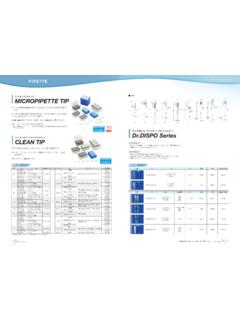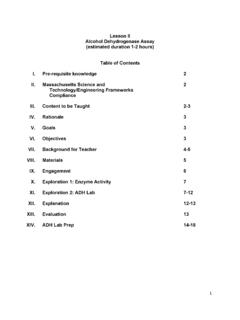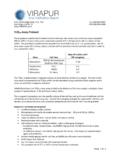Transcription of POLYNUCLEAR AROMATIC HYDROCARBONS by GC …
1 POLYNUCLEAR AROMATIC HYDROCARBONS by GC 5515 Table 1 MW: Table 1 CAS: Table 2 RTECS: Table 2 METHOD: 5515, Issue 2 EVALUATION: PARTIALI ssue 1: 15 May 1985 Issue 2: 15 August 1994 NIOSH:Table 3 PROPERTIES: Table 1 OSHA : COMPOUNDS:acenaphthenebenzo[ghi]perylene fluoreneacenaphthylenebenzo[a]pyreneinde no[1,2,3-cd]pyreneanthracenebenzo[e]pyre nenaphthalenebenz[a]anthracenechryseneph enanthrenebenzo[b]fluoranthenedibenz[a,h ]anthracenepyrenebenzo[k]fluorantheneflu orantheneSYNONYMS:PAH; PNA; also see Table :FILTER + SORBENT(2- m, 37-mm PTFE + washed XAD-2,100 mg/50 mg)FLOW RATE:2 L/minVOL-MIN:200 L -MAX:1000 LSHIPMENT:transfer filters to culture tubes; wrap sorbentand culture tubes in Al foil; ship @ 0 CSAMPLE STABILITY:unknown; protect from heat and UV radiationFIELD BLANKS:2 to 10 field blanks per setMEDIA BLANKS:6 to 10 AREA SAMPLES:8 replicates on preweighed filters forsolvent selectionMEASUREMENTMETHOD:GAS CHROMATOGRAPHY, CAPILLARYCOLUMN, FIDANALYTE:compounds aboveEXTRACTION:5 mL organic solvent appropriate tosample matrix (step 7)INJECTION VOLUME:4 L; 10:1 splitCOLUMN:30 m x ID, fused silica capillary,1- m DB-5 TEMPERATURE-INJECTOR:200 C -DETECTOR:250 C -PROGRAM:130 to 290 C @ 4 C/minGASES-CARRIER:He @ 1 mL/min -MAKEUP:He @ 20 mL/minLOD:ca.
2 To g per sample [1]CALIBRATION:external standards in tolueneRANGE, LOD, and PRECISION (S r):EVALUATION OFMETHODACCURACYRANGE STUDIED, ACCURACY, BIAS, and OVERALLPRECISION (S rT):not measuredAPPLICABILITY: The working range for B[a]P is 3 to 150 g/m3 for a 400-L air sample. Specific sample sets may requiremodification in filter extraction solvent, choice of measurement method, and measurement : Any compound which elutes at the same GC retention time may interfere. Heat, ozone, NO2, or UV light maycause sample METHODS: This revises P&CAM 183 [2]. The spectrophotometric methods, P&CAM 184 and 186 [2], have not beenrevised. Method 5506 (HPLC) uses the same sampling technique and is more Manual of Analytical Methods (NMAM), Fourth Edition, 8/15/94 POLYNUCLEAR AROMATIC HYDROCARBONS by GC: METHOD 5515, Issue 2, dated 15 August 1994 - Page 2 of 7 extraction solvent: acetonitrile, benzene,*cyclohexane, methylene chloride,* or otherappropriate solvents, pesticide grade (step 7).
3 , pesticide , distilled, reference standards,* appropriate to thePAH-containing matrix stock solution, mg/mL.*Check purity of each PAH reference standardby GC/FID, HPLC/fluorescence and/or meltingpoint. Purify, if necessary, by 25 mg of each PAH into a 100-mLvolumetric flask; dilute to volume with six months if refrigerated and protectedfrom , , , filtered.*See SPECIAL : PTFE-laminated membrane filter,2- m pore size, 37-mm diameter (GelmanZefluor, Membrana, Pleasantown, CA, orequivalent), backed by a spacer (37-mmOD, 32-mm ID) cut from a cellulosesupport pad or SKC #225-23, in cassettefilter 1:If sampling is to be done inbright sunlight, use opaque orfoil-wrapped cassettes toprevent sample 2:Take filters to be preweighedfrom the filter package andallow to equilibrate 24 h withlaboratory atmosphere tube, connected to filter withminimum length PVC tubing.
4 Plastic capsare required after sampling. WashedXAD-2 resin (front = 100 mg; back = 50mg) (Supelco ORBO 43 or equivalent).Pressure drop at 2 L/min airflow to 2kPa (15 to 20 cm H2O). sampling pump capable of operatingfor 8 h at 2 L/min, with flexible connectingtubing. foil. , scintillation, 20-mL, glass, PTFE-linedcap. , bagged. tubes, PTFE-lined screw cap, 13-mmx 100-mm. , m, PTFE (for filtering samplesolutions). , or micropipets, 1- to 100- chromatograph with FID, electronicintegrator, and capillary column (page 5515-1). flasks, 10- and in laboratory: incandescent or UV-shielded Manual of Analytical Methods (NMAM), Fourth Edition, 8/15/94 POLYNUCLEAR AROMATIC HYDROCARBONS by GC: METHOD 5515, Issue 2, dated 15 August 1994 - Page 3 of 7 SAMPLING:SPECIAL PRECAUTIONS: Treat benzene,methylene chloride, and all POLYNUCLEAR aromatichydrocarbons as carcinogens.
5 Neat compoundsshould be weighed in a glove box. Spent samplesand unused standards are toxic waste. Regularlycheck counter tops and equipment with "blacklight" for fluorescence as an indicator ofcontamination by each personal sampling pump with a representative sampler in personal samples at 2 L/min for a total sample size of 200 to 1000 L. Take a concurrentset of eight replicate area samples at 2 to 4 L/min on preweighed, 2- m PTFE filters in an areaof highest expected PAH :The area samples are needed for solvent selection (step 7). after sampling, transfer the filter carefully with forceps to a scintillation vial. Holdfilter at edge to avoid disturbing the deposit. Cap the scintillation vial and wrap it in :This step is necessary to avoid loss of analytes due to sublimation and degradation the sorbent tube and wrap it in aluminum to laboratory in insulated container with bagged PREPARATION:NOTE:UV light may degrade PAH.
6 Use yellow, UV-absorbing shields for fluorescent lights or useincandescent samples upon receipt at optimum extraction the preweighed area filter samples to equilibrate 24 h with the laboratory the area filters. Determine total weight collected on the first pair of area filters with acetronitrile, the second with benzene, the third withcyclohexane, and the fourth with methylene chloride, according to step :Use alternate solvents, if appropriate. PAH of interest may be entrained within, andadsorbed by, particulate matter collected on the filter. It is necessary to determinethe solvent which maximizes recovery of the PAH from each sample matrix. Forexample, methylene chloride [3,4] and benzene:ethanol (4:1 v/v) [5] have beenrecommended for extraction of PAH from diesel exhaust the extracts for the PAH of interest (steps 10 through 18). Normalize the totalmass of PAH found to the mass of sample the solvent which gives the highest recovery of PAH of interest.
7 Use the solventchosen to extract the personal filter mL of the solvent chosen in step 7 to each scintillation vial containing a filter. Startmedia and reagent blanks at this and let stand 15 to 20 min in an ultrasonic :Soxhlet extraction may be required when large amounts of highly adsorptiveparticulate matter ( , fly ash or diesel soot) are PAH from each sorbent tube with a file in front of the primary (larger) sorbent section. Breaktube at score front glass wool plug and front sorbent section to a culture tube. Transfer backNIOSH Manual of Analytical Methods (NMAM), Fourth Edition, 8/15/94 POLYNUCLEAR AROMATIC HYDROCARBONS by GC: METHOD 5515, Issue 2, dated 15 August 1994 - Page 4 of 7sorbent section and the middle glass wool plug to a second culture mL toluene to each culture tube. Cap the culture samples to stand for 30 min. Swirl all sample extracts through an m membrane AND QUALITY daily with at least six working aliquots of calibration stock solution with toluene in 10-mL volumetric flasks ( , to 5,1, , , and g/mL).
8 Working standards and samples in the calibration graphs (peak area vs. g of each PAH per sample). and desorption recovery (R) from filters and desorption efficiency (DE) from sorbent tubes atleast once for each lot of filters and sorbent tubes used in the range of interest.(1)Filters. Using a microliter syringe or micropipette, spike four filters at each of fiveconcentration levels with calibration stock solution. Allow the filters to dry in the darkovernight. Analyze the filters (steps 8, 10, and 14 through 16). Prepare graphs of R :This step may not be used for some highly adsorptive particulate matrices forwhich calibration by the method of standard additions may be more accurate.(2)Sorbent tubes. Transfer an unused front sorbent section to a culture tube. prepare atotal of 24 culture tubes in order to measure DE at five concentration levels plus blanksin quadruplicate.
9 Using a microliter syringe or micropipette, add calibration stocksolution directly to sorbent. Cap culture tubes and allow to stand overnight in the dark. Analyze (steps 9, 10, and 14 through 16). Prepare graphs of DE vs. amounts R and DE at two levels for each sample set, in duplicate. Repeat determination of Rand DE graphs if checks do not agree to within 5% of DE at least three field blanks for each sample GC according to manufacturer's recommendations and to the conditions on page sample aliquot. Start temperature peak 1:Approximate retention times appear in Table 2:If peak area is above the calibration range, dilute with appropriate solvent,reanalyze, and apply dilution factor in 3:If sample has many interferences, additional sample cleanup may be necessary. Many cleanup procedures have been published. Liquid-liquid partitioning betweencyclohexane and nitromethane [6,7] is widely used, but other techniques may bemore appropriate for specific the mass, g (corrected for R or DE) of each analyte found on the filter (W) and frontsorbent (Wf) and back sorbent (Wb) sections, and on the average media blank filter (B) and frontsorbent (Bf) and back sorbent (Bb) sections from the calibration concentration, C (mg/m3), in air as the sum of the particulate concentration and thevapor concentration using the actual air volume sampled, V (L).
10 NIOSH Manual of Analytical Methods (NMAM), Fourth Edition, 8/15/94 POLYNUCLEAR AROMATIC HYDROCARBONS by GC: METHOD 5515, Issue 2, dated 15 August 1994 - Page 5 of 7 EVALUATION OF METHOD:Owing to large interferences that occured while utilizing NIOSH Method P&CAM 206 for samplescollected during asphalt roofing operations, the gas chromatographic capillary column method wasdeveloped. The GC method has been evaluated using several hundred field filter and sorbent tubesampling trains. To date, no statistical studies have been initiated. Overall, standard spiked filters andsorbent tubes have yielded reproducible measurement calibration graphs. The method has beenapplied to the following sources with semi-quantitative results using three separate particulate extractionsolvents (benzene, cyclohexane, acetonitrile): aluminum reduction facilities, asphalt fume, coalgasification plants, coal liquefaction plants, coal tar pitch, coke oven emissions, creosote treatmentfacilities, diesel exhaust, graphite electrode manufacturing, petroleum pitch, and roofing tearoff : [1]UBTL, Inc.

















